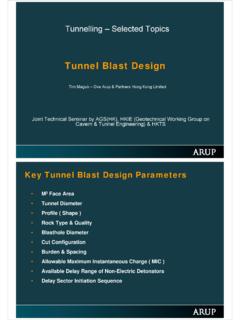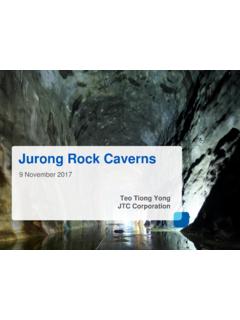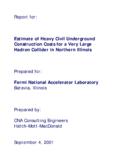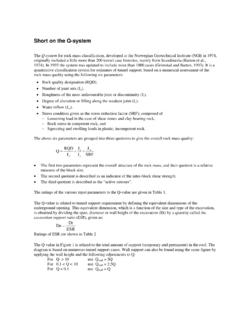Transcription of Tunnels and Caverns in Hong Kong - hkieged.org
1 Tunnels and Caverns in hong kong Working Group on Cavern and tunnel Engineering hong kong Institution of Engineers Geotechnical Division Abstract: Many Tunnels and Caverns have been successfully constructed in hong kong . These underground structures cater for water supply, mass transportation (such as railways and roads), drainage, conveyance of sewage and electrical cables, as well as for under-ground space development (such as concourse for mass transit railways, sewage treatment plant and refuse transfer station and explo-sives depot). This paper summarizes the historical and recent developments in relation to Tunnels and Caverns in hong kong . It also outlines the recent developments in risk management of tunnel works and the research being carried out by the local universities. 1 INTRODUCTION The population of hong kong has increased steadily from about million in 1950 to about 7 million today.
2 Intense urbaniza-tion and infrastructure development, combined with limited land availability and a growing awareness of environmental issues has driven hong kong s need to develop its underground space. This has resulted in the construction of numerous Tunnels and Caverns . In December 2003, the hong kong Institution of Engineers (HKIE) Geotechnical Division Committee (GDC) formed an in-terest group on cavern engineering. This subsequently developed into a group on cavern and tunnel engineering and was renamed as the Working Group on Cavern and tunnel Engineering in March 2005. Membership of the Working Group include repre-sentatives from the Geotechnical Engineering Office (GEO) of the Civil Engineering and Development Department (CEDD) of the HKSAR Government, the Kowloon-Canton Railway Corpo-ration (KCRC), the MTR Corporation Ltd (MTRCL), consultants, contractors and the universities.
3 The terms of reference of the Working Group are as follows: (a) Consolidate local and international knowledge, experience and practice in cavern and tunnel engineering. (b) Identify key issues on and actions required for appropriate use of Caverns and Tunnels in hong kong . (c) Promote awareness among professionals, clients and the relevant authorities of the potential and benefits of Caverns and Tunnels in hong kong . (d) Make recommendations to the HKIE GDC on follow-up ac-tions to be taken for promoting cavern and tunnel engineer-ing good practice in hong kong . (e) Promote technical exchanges between practitioners in hong kong and overseas. This paper summarizes the historical and recent developments in relation to Tunnels and Caverns in hong kong . It is based largely on published papers, including those given in the pro-ceedings of the 26th Annual Seminar of the HKIE GDC held on 12 May 2006 on Cavern and tunnel Engineering, as well as in-formation provided by members of the Working Group and client organizations.
4 Because of its scope, this paper will only refer to some relevant literature without going into details. For the purpose of this paper, tunnel works comprise Tunnels , shafts, Caverns and associated underground facilities, however constructed. The rock and soil descriptions given in this paper follow the recommendations of Geoguide 3: Guide to Rock and Soil Descriptions (GEO, 1988), which is the standard commonly adopted in hong kong . 2 GEOLOGY Volcanic and granitic rocks are found in about 85% of hong kong s landscape, with the former covering approximately 50% of the land area. The remaining 15% are sedimentary rocks, ex-posed mostly in the northern and northeastern New Territories. The abundance of massive hard crystalline volcanic and granitic rocks makes hong kong particularly suitable for tunnelling and underground development.
5 The near-surface rocks in hong kong have been subjected to chemical weathering, which has resulted in variable decomposi-tion and solution of the rock-forming grains and minerals to more chemically stable components. This process is primarily pro-moted by the flow of groundwater in pre-existing discontinuities. Corestone development associated with a gradational weathering profile is common in widely jointed coarser grained rocks, whereas in finer grained rocks, which have relatively close dis-continuity spacing, few corestones may be present and the rock-soil interface (rockhead) may be sharply defined. Microfractures associated with tectonic stresses and stress-relief or hydrothermal alteration can significantly affect the rock strength. The geology and general pattern of the main inferred faults in hong kong is shown in Figure 1. The laterally persistent north-east to east-northeast trending faults strongly influence the pre-sent day topography of hong kong .
6 Northwest-trending faults are generally shorter (up to 20m) and less continuous. Some ma-jor faults are associated with zones of deep weathering. The faults can play a significant role in controlling the engineering geological and hydrogeological properties of the rock mass, a good understanding of which is vital for the design and construc-tion of tunnel works. While weathering and structural geology govern the require-ments for tunnel support to ensure ground stability, hydrogeology plays an important role in respect of assessment of groundwater ingress into Tunnels during their construction, the drawdown of groundwater pressures outside the Tunnels and the consequential settlement of the ground and the facilities that the ground sup-ports. Due to the presence of joints, faults and other discontinui-ties in the rock mass, and its weathering characteristics, there can be significant uncertainty in the hydrogeology within the ground mass in hong kong .
7 The magnitude and direction of insitu stress in the rock mass can be important considerations in the design and construction of tunnel works in rock. For example, high horizontal stresses nor-mal to the axis of a tunnel or a cavern are usually beneficial for stability of the roof. The results of selected insitu stress meas-urements carried out in hong kong indicate that the principal 1 Fig. 1. Simplified geological map of hong kong (from Sewell et al., 2000) horizontal stress in rock is in excess of the vertical stress at depths of less than about 150m (Klee et al, 1999; Free et al, 2000; Ng & Wardall, 2005). The scatter in stress ratio and orientation of maximum horizontal stress is due to factors such as the influ-ence of topography at relatively shallow depth, locked-in stresses from different stress regimes over geological time, and proximity to major geological structures.
8 Thick colluvial deposits can also be present on the hillsides especially along the foothills. The strength, compressibility, permeability and consolidation characteristics of these materials, as well as the groundwater regime, can be of engineering signifi-cance if the tunnel works are to be constructed through or below them. Further discussion on material and mass weathering char-acteristics, development of ground models, and the key engineer-ing geological issues related to tunnel works in hong kong is given in GEO (2006a). 3 Tunnels AND Caverns IN hong kong Topography About 47% of the land in hong kong is greater than 100m above sea level, and 12% exceeds 300m. The limitations on flat land have necessitated the construction of Tunnels and Caverns to sup-port hong kong s built environment. There are 32 peaks higher than 500m; three of these rise above 800m. Tunnels have been built through many of these hills in-cluding Beacon Hill (457m), Eagles Nest (312m), Lin Fa Shan (578m), Lion Rock (495m), Ma On Shan (702m), Needle Hill (532m), Smugglers Ridge (337m), Tai Mo Shan (957m) and Tate s Cairn or Tai Lo Shan (577m).
9 In addition to the Tunnels through the hills, many Tunnels have also been constructed in the low lying urban and sub-sea areas. Water Supply Tunnels Early settlements on hong kong Island relied on streams, sup-plemented from 1852 by wells. The first reservoir was opened in 1863 in the Pok Fu Lam valley. This was replaced by a larger one in 1871. Tai Tam Reservoir was constructed in 1889 and in-cluded a tunnel to transfer water to Victoria (Surveyor General, 1884; 1885). The scheme was expanded, and Wong Nai Chung Reservoir was opened in 1899, with three further Tai Tam Reservoirs between 1904 and 1917, plus the Aberdeen Reser-voirs in 1931 and 1932 (Ho, 2001). In Kowloon, the first Kowloon Reservoir opened in 1910, and three more were completed between 1925 and 1931. The 2km long Shing Mun Tunnels were built in 1926 (Woodward, 1935). During the early 1960s, the demand for water increased as sev-eral years of low rainfall led to water shortages and severe ration-ing.
10 As part of the Shek Pik Scheme, 17km of Tunnels were completed in 1963, and this included a tunnel conveying water from the Shek Pik Dam on Lantau Island to Silvermine Bay. Concurrently, the long Tung Chung tunnel was built in 1963. The Tam Lam Chung Tunnels , about long, were built in the period 1957 to 1974. Plover Cove and High Island were dammed and filled with fresh water. During the period from 1965 to 1971, of Tunnels were constructed to augment the natural catchments with 2 water from adjacent watersheds under the Plover Cove Water Scheme (Ford & Elliot, 1965; Garrod, 1966). About 40km of Tunnels were built in 1976 to divert fresh water to the High Island Reservoir ( Tunnels & Tunnelling, 1971; Don et al, 1973; Vail et al, 1976). In the 1980s, a number of aqueduct schemes were imple-mented. Agreement was reached between the hong kong Gov-ernment and the Guangdong Provincial Authority for the water supply to hong kong to be increased by approximately equal an-nual increments from 220 million cubic metres in 1982 to 660 million cubic metres in 1994.












